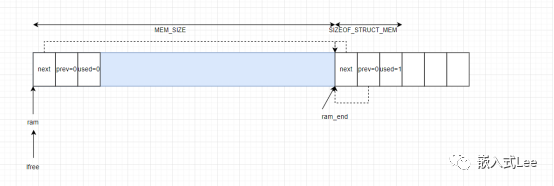堆管理是重点的基础代码,需要重点关注,移植时也需要关注。所以这一篇就来讲讲LWIP的堆管理。
LWIP实现了内部的堆管理,这样无OS等环境也可以直接移植使用,不依赖系统的堆管理。
当然也可以配置为使用系统的堆管理。
源码位于mem.c,mem.h
如果使能MEM_LIBC_MALLOC则使用系统的堆管理接口
需要配置以下宏
mem_clib_free
mem_clib_malloc
mem_clib_calloc
默认是
/* in case C library malloc() needs extra protection,* allow these defines to be overridden.*/
如果使能MEM_USE_POOLS则使用内存池实现,这个上一篇已经讲解了。
否则使用mem.c的实现,我们重点关注这一部分。
如果没有定义LWIP_RAM_HEAP_POINTER则
mem.c中定义一个大数组LWIP_DECLARE_MEMORY_ALIGNED
大小是MEM_SIZE_ALIGNED + (2U * SIZEOF_STRUCT_MEM)
用户可用空间是#define MEM_SIZE_ALIGNED LWIP_MEM_ALIGN_SIZE(MEM_SIZE)
即用户定义的MEM_SIZE,默认值是1600
/*** MEM_SIZE: the size of the heap memory. If the application will send* a lot of data that needs to be copied, this should be set high.*/
这里多分配了2U * SIZEOF_STRUCT_MEM是一方面多一个ram_end标记末尾,作为末尾的边界节点,一方面预留对齐的浪费空间。
用户也可以直接定义宏LWIP_RAM_HEAP_POINTER指定存储的位置。
个人觉得这里LWIP_RAM_HEAP_POINTER静态指定,改为指针变量,初始化变量值为LWIP_RAM_HEAP_POINTER,然后也可以通过接口设定会更好。这样用户可以根据实际情况动态分配出这部分存储来,否则静态分配,程序不运行也要占用空间比较浪费。
LWIP_DECLARE_MEMORY_ALIGNED
实现如下
/** If you want to relocate the heap to external memory, simply define* LWIP_RAM_HEAP_POINTER as a void-pointer to that location.* If so, make sure the memory at that location is big enough (see below on* how that space is calculated). *//** the heap. we need one struct mem at the end and some room for alignment */LWIP_DECLARE_MEMORY_ALIGNED(ram_heap, MEM_SIZE_ALIGNED + (2U * SIZEOF_STRUCT_MEM));/** Allocates a memory buffer of specified size that is of sufficient size to align* its start address using LWIP_MEM_ALIGN.* You can declare your own version here e.g. to enforce alignment without adding* trailing padding bytes (see LWIP_MEM_ALIGN_BUFFER) or your own section placement* requirements.* e.g. if you use gcc and need 32 bit alignment:* \#define LWIP_DECLARE_MEMORY_ALIGNED(variable_name, size) u8_t variable_name[size] \_\_attribute\_\_((aligned(4)))* or more portable:* \#define LWIP_DECLARE_MEMORY_ALIGNED(variable_name, size) u32_t variable_name[(size + sizeof(u32_t) - 1) / sizeof(u32_t)]*/
核心数据结构如下struct mem
/**
* The heap is made up as a list of structs of this type.
* This does not have to be aligned since for getting its size,
* we only use the macro SIZEOF_STRUCT_MEM, which automatically aligns.
*/
struct mem {
/** index (-> ram[next]) of the next struct */
mem_size_t next;
/** index (-> ram[prev]) of the previous struct */
mem_size_t prev;
/** 1: this area is used; 0: this area is unused */
u8_t used;
#if MEM_OVERFLOW_CHECK
/** this keeps track of the user allocation size for guard checks */
mem_size_t user_size;
#endif
};
一个双向链表来实现,该结构体描述某一个区块,used表示当前区块是否使用。
Next和prev分别指向前后区块,用于入链表和出链表操作。
这里为什么没有描述本区块大小的字段呢?
因为可以直接从next减去当前区块的基地址得到,所以不需要额外的大小信息了。
比如当前区块基地址是ptr则当前区块可用于分配的有效空间如下计算
(mem->next - (ptr + SIZEOF_STRUCT_MEM))
即后一个区块的开始的地址-本区块开始地址-信息头。
这个实现其实和uCOS的堆管理实现差不多。
初始化时,初始全局变量ram即对齐后的存储空间,
lfree指向空闲块的开头,初始化时为ram,
lfree始终用于指向未分配的区块。
此时只有一个整的未分配的区块,next指向MEM_SIZE后,
MEM_SIZE外ram_end用于标记结束,这也是之前存储多分配的原因。

分配算法核心思想如下,
从lfree开始查找空闲空间大于等于需求size的块。
如果找到了就分配它。
这里有一个处理,如果本块比较大,则分配了size后还有剩余,所以要拆分,即分配出size后剩余的部分成为空闲块。
这个到底多大要拆分,标准是大于等于(size + SIZEOF_STRUCT_MEM + MIN_SIZE_ALIGNED)拆分,即可用空间是MIN_SIZE_ALIGNED才拆分。
分配完后,如果分配出的块刚好是lfree位置,则要更新lfree指向后续空闲块。
因为lfree始终是指向的空闲块,即lfree链接起来的都是空闲块。分配出的块就从lfree中去掉了。
比如分配黄色空间后如下

注意返回的是结构体之后的可用空间部分。
将区块链接到lfree空闲块中去,如果该块前后为空闲则和前后拼接成大的空闲块。
mem = (struct mem *)(void *)((u8_t *)rmem - (SIZEOF_STRUCT_MEM + MEM_SANITY_OFFSET));
先偏移结构到块头。
如果mem小于lfree则要更新lfree为mem。
核心处理是plug_holes,判断mem前后是否空闲,如果是空闲则和前后合并。
缩小
如果本块缩小后剩余的空间不够SIZEOF_STRUCT_MEM + MIN_SIZE_ALIGNED,则没有必要缩小,不处理。
如果缩小后剩余空间大于上述大小则看next是否空闲如果是则和next合并,否则单独独立出来一个空闲块。
LWIP实现了小型的堆管理,这样无OS也可以直接移植使用,另外也可以配置为实用内存池和系统实现,比较灵活。